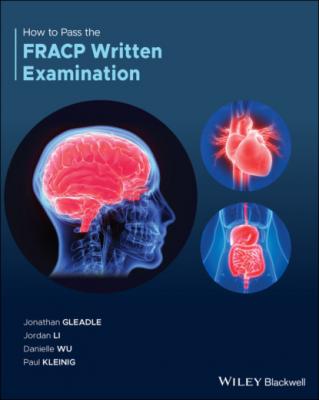How to Pass the FRACP Written Examination. Jonathan Gleadle
Читать онлайн.| Название | How to Pass the FRACP Written Examination |
|---|---|
| Автор произведения | Jonathan Gleadle |
| Жанр | Медицина |
| Серия | |
| Издательство | Медицина |
| Год выпуска | 0 |
| isbn | 9781119599548 |
| Potassium level in first 24hrs (mmol/L) | Potassium replacement |
| >5.5 | Nil |
| 3.5–5.5 | 30 mmol |
| <3.5 | ICU admission, replacement 10 mmol/L/hr |
Intravenous insulin infusion with Actrapid should be started as soon as possible and boluses of insulin should be avoided unless there is significant delay (≥1 hour) in setting up an insulin infusion. Insulin infusion should not be stopped until the patient is eating and drinking normally and ketones <0.3 mmol/L, venous pH >7.35, and the patient has received a bolus of long‐acting subcutaneous insulin as part of transition to subcutaneous basal bolus insulin regimen.
Sodium bicarbonate should not be administered in patients with DKA unless the arterial plasma pH falls below 7. However, this decision should be individualised. Most patients with DKA do not require the administration of sodium bicarbonate, since infused insulin will slow the rate of ketoacid production, and bicarbonate ions will be produced when ketoacid anions are oxidised.
Karslioglu French E, Donihi A, Korytkowski M. Diabetic ketoacidosis and hyperosmolar hyperglycemic syndrome: review of acute decompensated diabetes in adult patients. BMJ 2019;365:l1114
https://www.bmj.com/content/365/bmj.l1114
10. Answer: C
Erectile dysfunction (ED) is defined as persistent inability to achieve or maintain an erection adequate for satisfactory sexual activity. After premature ejaculation, it is the most common disorder of sexual function in men. ED is a natural part of ageing and prevalence increases with age. Due to its effects on blood vessels and nerves systemically and in the penis, diabetes is a common aetiology of ED. Men with diabetes are four times more likely to experience ED, and on average, ED develops 15 years earlier than in men without diabetes. ED and/or decreased libido are common side‐effects of many medications; drugs which can cause this include β‐blockers, hydrochlorothiazides, and SSRIs. The pathogenesis of organic ED is related to dysfunction of the endothelium.
Guidelines recommend screening for low testosterone with a morning total testosterone assay (08.00–11.00 a.m.) in men with ED and hypoactive sexual desire, incomplete response to phosphodiesterase type 5 (PDE5) inhibitors, delayed ejaculation, and in all men with known diabetes. The prevalence of low total testosterone levels in men with ED varies widely across studies and ranges from 12.5% to 35%. The threshold of testosterone to maintain an erection is low (< 5.5 nmol/L) and ED is usually a symptom of more severe cases of hypogonadism. If total testosterone level is ≥ 12 nmol/L, testosterone deficiency is unlikely. If total testosterone is < 12 nmol/L, a second morning venous blood sample drawn after an interval of at least one week, together with serum luteinising hormone and prolactin levels is required.
ED may be a precursor of cardiovascular disease. Men with proven or suspected vasculogenic ED or multiple vascular risk factors, especially diabetes, should be screened for silent myocardial ischaemia with exercise electrocardiography, a coronary artery calcium score, or coronary CT angiography.
Lifestyle modifications are the first‐line therapy. Other treatment options include testosterone replacement therapy (TRT), PDE5 inhibitors, intracavernosal injection therapy, vacuum constriction devices (VCDs), intraurethral prostaglandin suppositories and surgical placement of a penile prosthesis. PDE5 inhibitors enhance blood flow in the corpora cavernosa. 60–65% of men who have ED, including those with hypertension, diabetes, spinal cord injury, and other comorbid medical conditions, can successfully complete intercourse in response to the PDE5 inhibitors. There is no evidence that currently approved ED treatments add to the overall cardiovascular risk in patients with or without previously diagnosed cardiovascular disease.
McMahon CG. Current diagnosis and management of erectile dysfunction. MJA 2019;210:469–76.
https://www.mja.com.au/journal/2019/210/10/current-diagnosis-and-management-erectile-dysfunction
11. Answer: A
Fertility preservation may be requested by women who experience disease processes or treatments that carry a risk of premature ovarian failure, thereby potentially extending their ability to have children. Treatments causing premature ovarian failure include alkylating chemotherapeutic agents, multi‐agent chemotherapy, ovarian radiation therapy, and sometimes pelvic surgery. Alkylating agents include nitrogen‐mustard agents such as cyclophosphamide, nitrosureas, and busulfan carry the highest risk of premature ovarian insufficiency, with increasing risk in a dose dependent manner. Other agents with alkylating like actions such as platinum containing agents also carry increased risk, as do other treatments for malignancy such as pelvic radiotherapy.
Counselling about risk of premature ovarian failure is recommended for women of childbearing age undergoing high risk treatments, and parents of children undergoing the same. The probability of premature ovarian failure following chemotherapy is dependent on individual ovarian reserve, which varies greatly between women. For prepubertal girls, ovarian tissue cryopreservation is most likely to result in successful outcome. In adults, this strategy is emerging in cases where there is an urgent indication to initiate treatment, leaving no time for oocyte or embryo cryopreservation. However, where treatment can be safely delayed, mature oocyte cryopreservation or embryo cryopreservation are currently the methods endorsed by the Clinical Oncology Society of Australia. Successful pregnancy rates are higher when larger numbers of oocytes are used, or where the donor is of younger age at the time of cryopreservation.
Donnez
